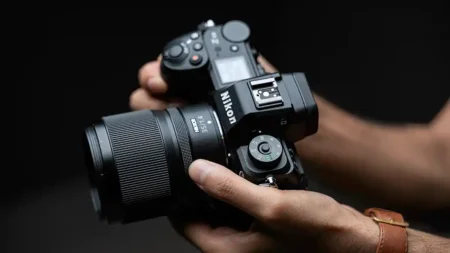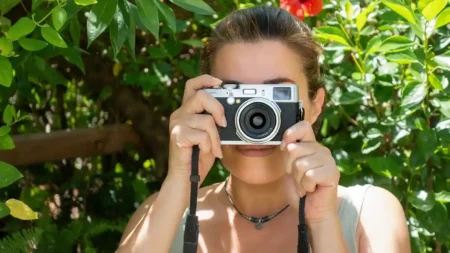Canon has officially announced the release of its latest cinema camera, the Canon EOS C80. You could initially mistake this much-anticipated addition to the company’s Cinema EOS range as a replacement for the popular C70, but with it’s full-frame sensor, it will, in fact, sit just above the older model in the lineup.
The Canon EOS C80 aims to bridge the gap between the Canon EOS C70 and higher-end models like the EOS C400, offering full-frame 6K video recording at a price point that’s accessible to a greater number of filmmakers. The camera also offers an ideal lightweight and cheaper additional camera option to production companies to support the C400.
The camera delivers many of the advanced features found in the higher-end C400, such as the full-frame 6K BSI sensor and Dual Pixel CMOS AF II, but at a more affordable price. Likewise, C70 users looking for a step-up to full frame but wanting to stick to the familiar and versatile size of the C70 will find that the C80 will meet most of their wish lists.
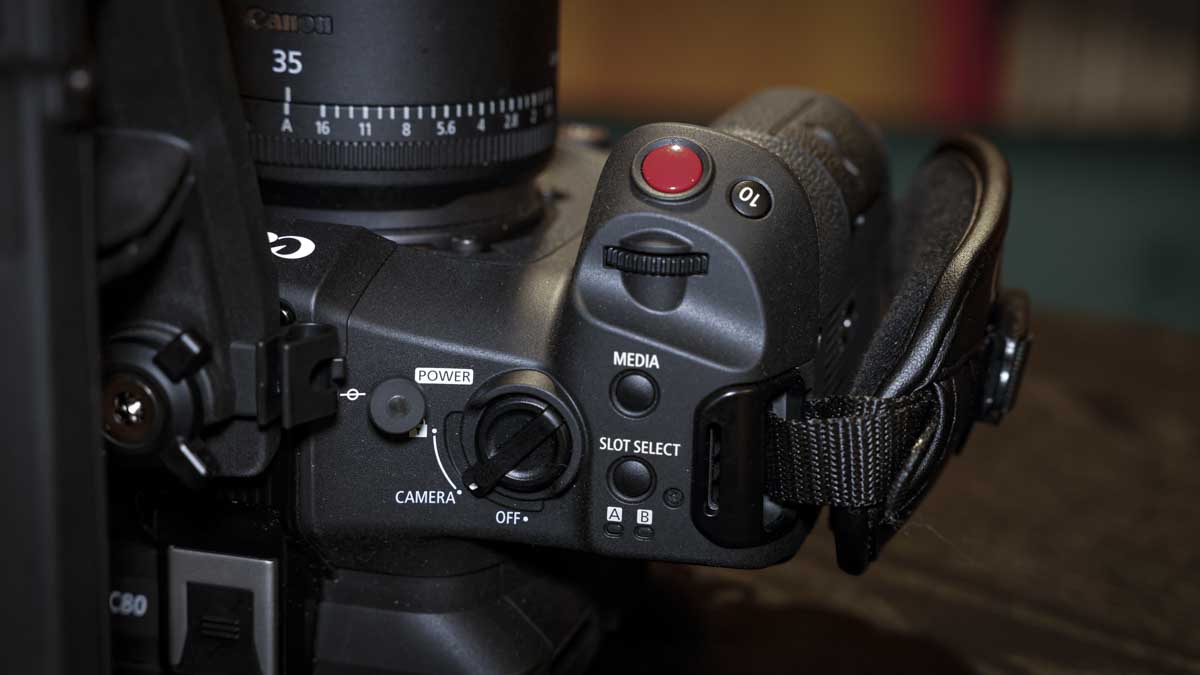
The C80’s position in Canon’s lineup makes it a great option for a wide range of creators, including independent filmmakers, documentary shooters, live event producers, and those working in VFX and virtual production.
The Canon EOS C80 will launch in September 2024 and will retail for approximately £5,500 / $6,500.
Top 10 Features of the Canon EOS C80
The Canon EOS C80 is packed with features and handling that essentially blend the design, usability, and advanced video capture technology of the Canon EOS C70 and Canon EOS C400. Below is a breakdown of some of those key features.
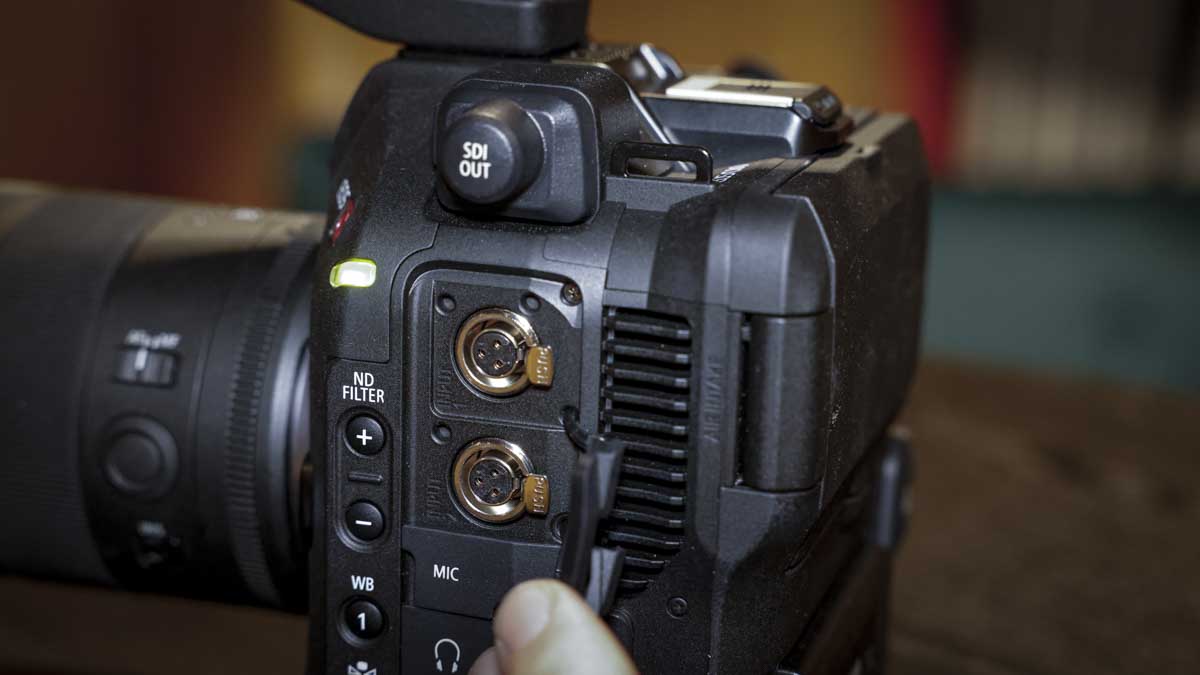
- 6K Full-Frame BSI Sensor: The EOS C80 features a full-frame Back-Side Illuminated sensor, delivering sharp, low-noise footage even in challenging lighting conditions.
- 16 Stops of Dynamic Range: Canon Log 2 provides up to 16 stops of dynamic range, allowing for high-quality HDR production.
- Triple Base ISO (800/3200/12800): This feature ensures optimal image quality across different lighting environments, whether you’re shooting in daylight or low light.
- 12-bit Cinema RAW Light Recording: The C80 supports 12-bit Cinema RAW Light, offering flexibility in post-production without the massive file sizes of full RAW.
- RF-Mount Compatibility: The RF-mount allows access to Canon’s latest range of high-quality lenses, as well as EF and PL lenses, through adapters.
- Dual Pixel CMOS AF II: Canon’s autofocus technology ensures precise focus, with tracking for faces, eyes, bodies, and animals.
- High Frame Rates: The C80 can shoot up to 120fps in 4K and 30fps in 6K, perfect for smooth slow-motion footage.
- 5-Axis Image Stabilisation: This feature provides stable handheld footage, which is crucial for dynamic shooting environments.
- Professional Connectivity: The C80, with 12G-SDI, HDMI, and two mini-XLR inputs, is designed for flexible workflows and live streaming.
- Compact Design: Despite its full-frame sensor, the camera maintains a compact form factor similar to the EOS C70, making it ideal for handheld or gimbal use.
Canon EOS C80: Full Specifications and Features Overview
The Canon EOS C80 brings a full-frame 6K sensor and high-end cinema features into a more compact and affordable package, essentially bringing many of the features of the C400 to the form factor of the popular C70. On paper, the C80 instantly strikes you with its impressive specifications, as well as the versatile formfactor that has been aimed at professional filmmakers, documentarians, and event videographers looking for a compact camera with advanced video capabilities.
The EOS C80 features a 6K full-frame Back-Side Illuminated (BSI) CMOS sensor, which offers a resolution of 19.05 megapixels when shooting at 6K. For filmmakers who need greater flexibility, the camera also supports a Super35 crop mode, making it adaptable to different production needs and especially useful if you’re using it alongside the C70s.

The 16 stops of dynamic range, particularly in Canon Log 2, should provide exceptional depth, allowing you to capture a wide range of light and shadow, perfect for HDR workflows.
Canon’s DIGIC DV7 image processor ensures smooth handling of high-resolution video and the camera supports a variety of recording formats, including 12-bit Cinema RAW Light, XF-AVC, and XF-HEVC to suit a variety of workflows. This choice makes the camera suitable for everything from high-end cinema productions to fast-turnaround broadcast environments.
As with the C70 the camera is equipped with dual SD card slots for internal recording. Although it lacks CFExpress card support like the higher-end C400, it still offers double-slot recording and relay recording, ensuring ample storage and reliable performance during long shoots.
When it comes to frame rates, the EOS C80 can record in 6K RAW at up to 30fps, if you’re looking to capture slow-motion footage, the camera can shoot 120fps in 4K and up to 180fps in 2K, ideal for slow-motion shots and creative effects. The Triple Base ISO (800, 3200, 12800) allows plenty of choice in various lighting conditions.
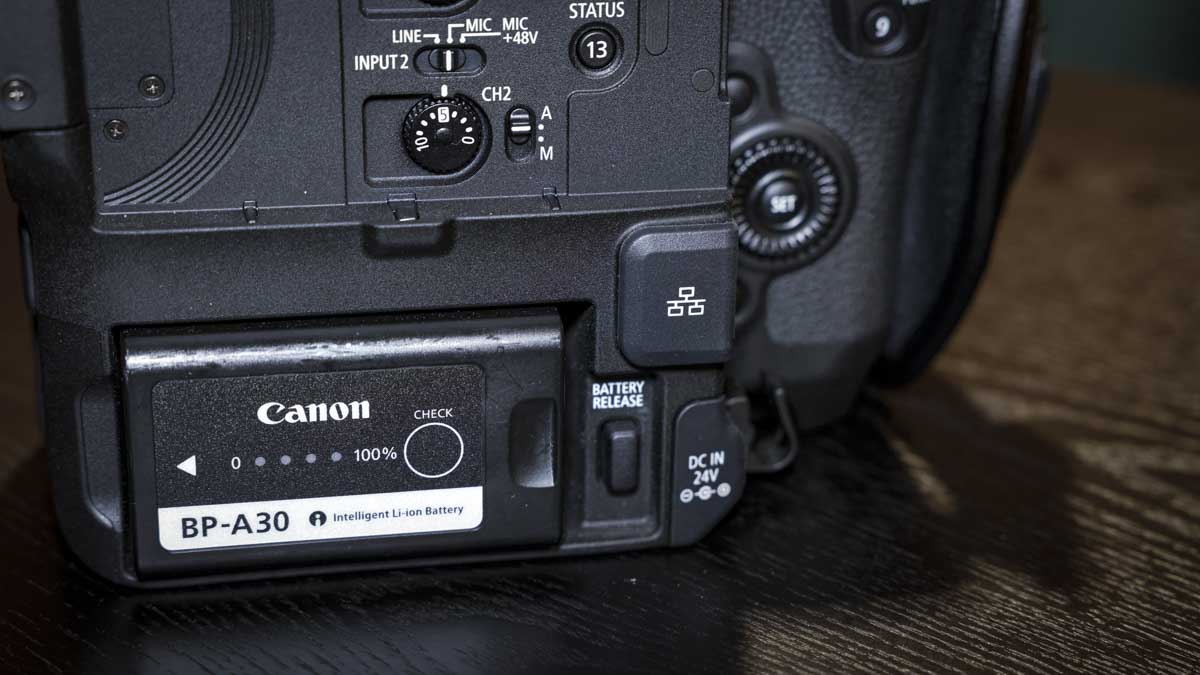
When it comes to stabalisation the EOS C80 is its 5-axis combination image stabilisation with the camera combining optical and digital IS, to ensure smooth, stable footage, even during handheld shooting. This feature is particularly useful for run-and-gun filmmaking, where the ability to shoot steady handheld footage is essential. The RF lens mount adds even more versatility and opens up an increasing selection of Canon’s cutting-edge RF lenses.
However, if you have already invested in EF or PL lenses, adapters are available, expanding the camera’s compatibility with an extensive range of lenses.
The build and design of the EOS C80 balance compactness and ergonomics. Weighing just 1310g and measuring 160 x 138 x 116mm, the camera is light enough for handheld shooting while still offering the robustness expected of a professional tool. Its body is slightly larger than the C70 but remains portable and well-suited for gimbal work. The camera’s 3.5-inch LCD touchscreen provides a clear and responsive interface for selecting focus points and controlling shooting settings.

Connectivity is another area where the EOS C80 includes 12G-SDI, HDMI, and two mini-XLR ports, ensuring seamless integration with external recorders, monitors, and professional audio equipment. The camera also supports Ethernet and Wi-Fi, enabling remote control and IP streaming.
The Dual Pixel CMOS AF II system with EOS iTR AF X offers advanced autofocus capabilities, including face, eye, and animal detection.
Canon has equipped the EOS C80 with built-in ND filters, offering 2, 4, and 6 stops of filtration, with an extended mode providing up to 10 stops. This feature enables you to shoot in bright outdoor conditions while maintaining control over depth of field, making it easier to achieve that cinematic shallow focus look without overexposing the image. This, combined with the camera’s ability to apply anamorphic lens support, gives you even more creative control.
The EOS C80 is powered by a BP-A30N battery, providing around 170 minutes of recording time when shooting 6K RAW at 30fps. For more demanding shoots, filmmakers can opt for the BP-A60 battery, which offers extended shooting time.

Hands on with the Canon EOS C80
The features set and design of the EOS C80 all look and sound impressive when on paper; however, it’s only when you get the camera in your hands that you can really start to feel the impact of all of those design changes and tweaks. For me, it’s the increase in body size that I was most interested in checking out, alongside that full frame sensor of course – part of the beauty of the Canon EOS C70 and EOS R5C is the small size, so to have the basis of a C400 in a C70 body has to raise some interest.
I have worked extensively with the Canon EOS C70, so was keen to see how this new model compared. From the outset, the similarities between the two models are evident, particularly in terms of handling. Despite being slightly larger than the C70, the C80 remains incredibly versatile and ergonomic – of note instantly is the new top handle that has been reshaped slightly and is incredibly comfortable. While this grip is just plastic, I really like its finish and quality. Checking over the rest of the body, the ports on the side are all well protected by rubber covers, and then on the back is the flip-out screen, which, as ever, is just large enough to touch screen. Hidden by the screen until it’s flipped out are the audio adjustment dials; this position sits better with me than on the side of the handle, which some other manufacturers favour. Essentially, if you’re familiar with the C70, then this is all tweaked but essentially the same.
The SD card ports are on the grip in exactly the same position as on the C70. I wasn’t a fan of these on the C70, and again, the fact that there’s no CFExpress slot is a shame, although most seem perfectly happy with the SD format.

However, the big feature of the EOS C80 is the new full-frame sensor, which provides a leap in image quality and creative potential for the camera at a price point that opens high-quality video production to a broader market. As a reference, the EOS C70 presently retails for £4392, while the EOS C400 £7799, placing the new camera directly in the middle.
So, let’s take a closer look at the camera and a few notes about my first impressions.
Handling and ergonomics
One of the first things I noticed about the EOS C80 was its balance. Although the body is larger than the C70, the increase in height is minimal, and it doesn’t impact the camera’s portability. The weight distribution is excellent, and despite its slightly larger size, it’s still perfect for handheld work or rigging to a gimbal. The grip feels comfortable, and the button layout will be instantly familiar to anyone who has used Canon’s cinema cameras before. The improved design of the top handle is a small but significant upgrade, offering better ergonomics and comfort when shooting handheld for extended periods.
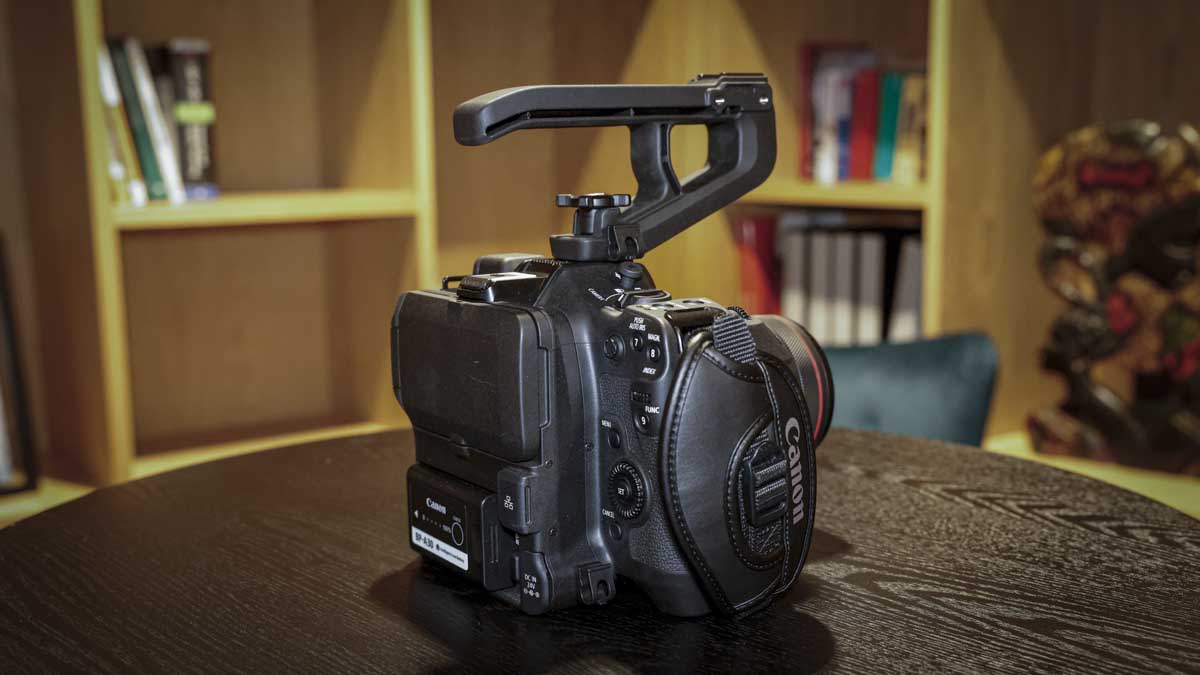
Canon’s full-frame sensor is a big feature, something previously reserved for the more expensive cameras in the EOS lineup, like the EOS C400. The C80 inherits many features from its higher-end sibling, such as the 6K full-frame Back-Side Illuminated (BSI) sensor. This sensor also boasts an impressive 16 stops of dynamic range, and Triple Base ISO (800, 3200, 12800) ensures great results regardless of the shooting conditions.
Full-frame sensor and image quality
The introduction of the full-frame sensor in the C80 is a significant step for Canon, especially at this price point, and also highlights that the C70 could well be followed with a C70 Mark II with a Super 35mm sensor at some point in the future facilitating that lower price point. This sensor, similar to the one found in the EOS C400, offers 6K resolution and opens up a lot of creative possibilities, especially when paired with Canon’s RF lenses. The full-frame look is ideal for filmmakers who want to achieve shallow depth of field and great low-light performance
The camera’s Dual Pixel CMOS AF II with EOS iTR AF X also performed well in the limited time I had with the camera with an ability to track with the AF to a speed that while not quite the equivelent to Canon stills cameras was still a step up from most video cameras.

Connectivity and versatility
Connectivity is another area where the EOS C80 looks to appeal with 12G-SDI, HDMI, and two mini-XLR ports. Whether you’re recording directly to an external recorder or live-streaming an event, while I couldn’t obviously test this during the hands on it’s great to see the potential that this camera offers. The built-in 5-axis electronic image stabilisation (IS) also ensures a decent degree of stabalisation and smooth footage when shooting handheld, again a feature that I’ll look at a little bit more in-depth in the future.
However, during my hands-on experience, I did find one drawback—the EOS C80 only accepts SD cards, like the C70, unlike the CFExpress Type-B cards supported by larger cameras like the EOS C400 and even the smaller EOS R5 C. While the V90 SD cards can keep up with the higher recording modes, the SD format lacks the durability and reliability of CFExpress cards. This restriction became noticeable during the demo, as I was using a V60 SD card, which limited the video quality I could test. The V60 couldn’t handle the camera’s higher recording modes, so the 12-bit Cinema RAW Light at 6K wasn’t fully explored during this session.
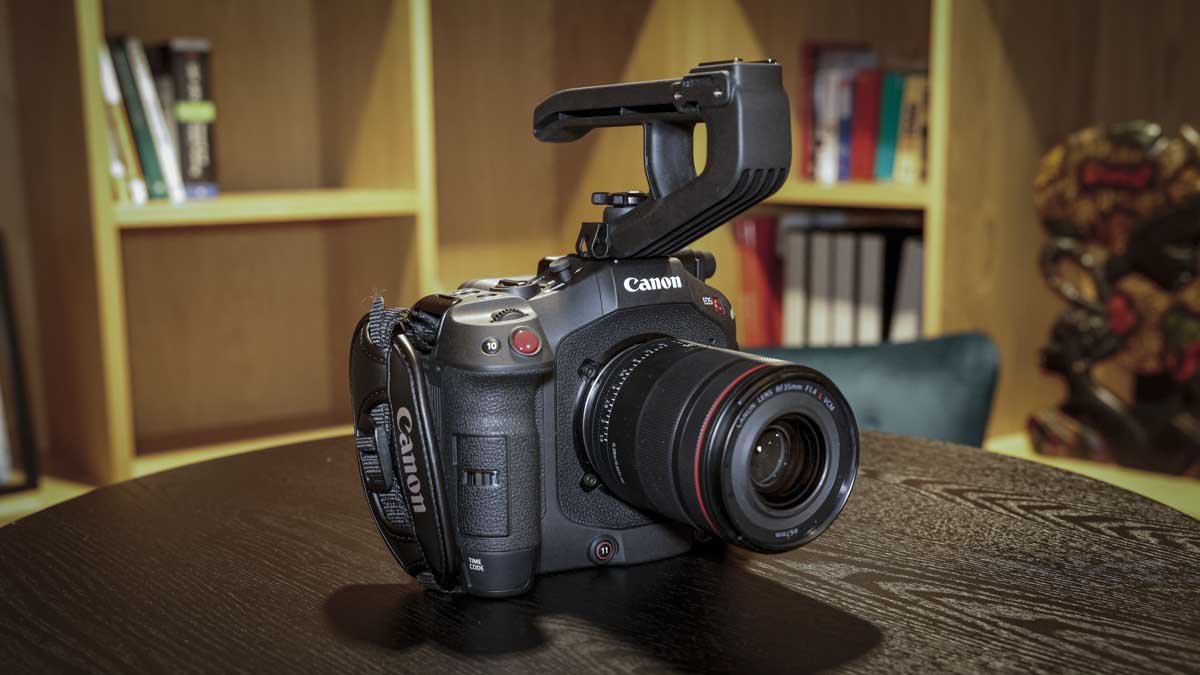
Despite this limitation, many users will likely pair the camera with external recorders, especially for high-end work. The combination of 12G-SDI and HDMI ensures that you can output high-quality footage to an external device without issue, and Canon’s internal RAW recording offers excellent image quality at a reduced file size when compared to full RAW.
Recording formats and performance
One of the most impressive aspects of the EOS C80 is the range of recording formats it supports. The camera can record in 12-bit Cinema RAW Light at 6K resolution, which offers immense flexibility for post-production, especially when it comes to colour grading. You also have access to XF-AVC 4K 4:2:2 10-bit and XF-HEVC recording formats for broadcast-quality footage. For most productions, this will be more than enough.
In terms of high frame rate shooting, the EOS C80 can record up to 120fps in 4K and 30fps in 6K, making it a solid choice for filmmakers who need slow-motion capabilities. Again I’ll bring you more on this in the future but a look through the menus highlighted what was available..
Build quality and design.
The EOS C80 borrows heavily from the EOS C70 in terms of design, but it has been refined with a slightly larger body to accommodate the full-frame sensor. Despite the increase in size, the camera feels balanced and easy to handle. Canon has also upgraded the LCD panel, making it brighter and more usable in outdoor conditions. The redesigned joystick is now closer to the thumb, offering better control when navigating menus, and the improved top handle offers enhanced comfort during handheld shooting.

For those working in virtual production or with VFX, the EOS C80 supports real-time lens metadata and distortion correction, which significantly simplifies workflows. Canon’s RF mount also makes the camera compatible with a wide range of high-quality lenses, including the RF 5.2mm F2.8L Dual Fisheye Lens for immersive VR content.
Pricing and availability
The Canon EOS C80 will be available in September 2024 for £5,500 / $6,500. This makes it a competitive option for professional filmmakers and videographers looking for a full-frame cinema camera without breaking the bank. It sits comfortably between Canon’s entry-level cinema cameras and high-end models like the C400, providing an accessible yet powerful option for various types of productions.

